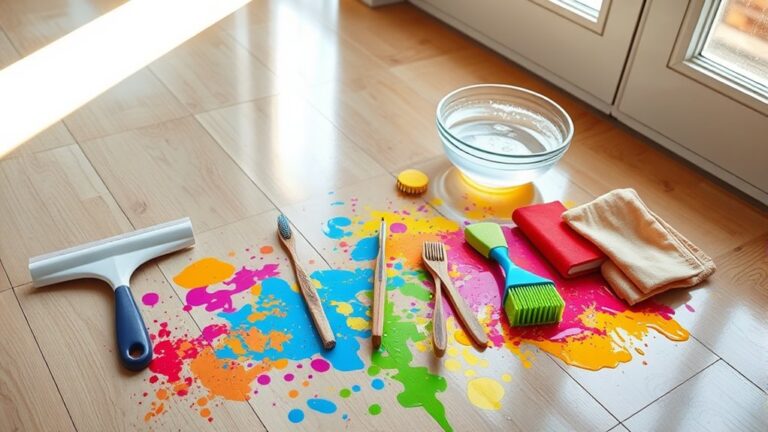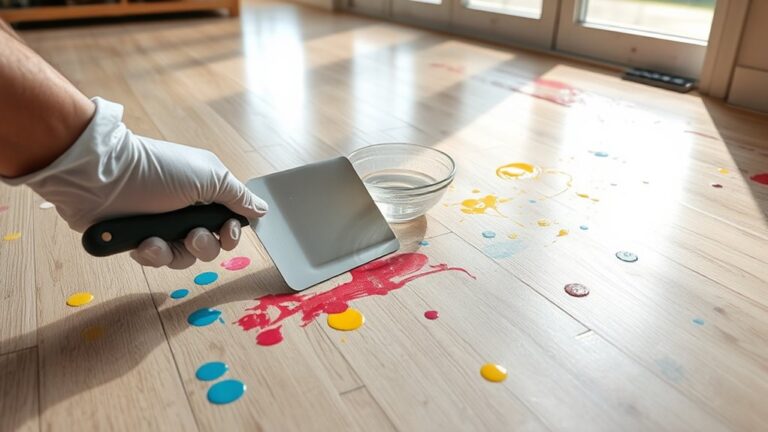Puede gestionar eficazmente la sensibilidad al ruido incorporando soluciones de insonorización para suelos. Considere materiales como vinilo de alta densidad, espuma acústica o moquetas de alta densidad para absorber las ondas sonoras y minimizar el ruido de impacto. Las opciones de base, como el corcho y el caucho, proporcionan un aislamiento acústico adicional. Las técnicas de instalación adecuadas, como la preparación del subsuelo y el uso de una base de calidad, mejoran el rendimiento. Sellar los huecos alrededor de puertas y ventanas reduce aún más las fugas de sonido. Además, evalúe sus fuentes de ruido específicas para elegir la solución adecuada. Explorar diversos materiales y estrategias puede generar un entorno más confortable, adaptado a sus necesidades de sensibilidad al ruido.
Comprensión de la sensibilidad al ruido
La sensibilidad al ruido varía considerablemente entre personas, y algunas experimentan una mayor incomodidad al responder al sonido. Esta sensibilidad puede manifestarse a través de diversos desencadenantes de ruido, como conversaciones en voz alta, maquinaria o incluso ruido ambiental. En tu caso, estos desencadenantes pueden provocar una sobrecarga sensorial, un estado en el que el cerebro se ve abrumado por un exceso de información auditiva, lo que provoca estrés, ansiedad o incluso malestar físico.
Comprender tu sensibilidad específica al ruido es vital para gestionar su impacto en tu vida diaria. Podrías notar que ciertas frecuencias o volúmenes provocan reacciones más intensas, lo que indica una mayor vulnerabilidad a ciertos sonidos. Esta reacción suele deberse al procesamiento cerebral de los estímulos auditivos, donde ciertos ruidos pueden perturbar tu sensación de seguridad y bienestar.
En entornos con ruido excesivo, el riesgo de sobrecarga sensorial aumenta considerablemente. Es posible que la exposición prolongada a estos desencadenantes de ruido no solo aumente su incomodidad, sino que también afecte su capacidad para concentrarse, comunicarse o realizar actividades cotidianas. Identificar y mitigar estos desencadenantes es esencial para mantener un espacio vital seguro y confortable.
Considerar la sensibilidad al ruido es especialmente relevante en entornos como hogares, lugares de trabajo o espacios públicos. Un enfoque proactivo implica reconocer sus desencadenantes específicos e implementar estrategias para minimizar su impacto. Al comprender su relación única con el sonido, puede tomar las medidas necesarias para crear un entorno más seguro que promueva el bienestar general y reduzca la probabilidad de sobrecarga sensorial.
Tipos de materiales de amortiguación del sonido
Al considerar materiales de insonorización, los paneles de espuma acústica y el vinilo de carga masiva son dos opciones eficaces. Los paneles de espuma acústica absorben las ondas sonoras, reduciendo el eco y la reverberación, mientras que el vinilo de carga masiva proporciona una barrera densa que bloquea la transmisión del sonido. Comprender las propiedades de cada material le ayudará a tomar una decisión informada sobre sus necesidades de insonorización.
Paneles de espuma acústica
Los paneles de espuma acústica son componentes fundamentales en las soluciones de insonorización, especialmente para quienes buscan minimizar la transmisión del sonido en diversos entornos. Estos paneles están diseñados para absorber las ondas sonoras, reduciendo los niveles de ruido y mejorando la calidad acústica. Al considerar la ubicación de los paneles acústicos, es fundamental ubicarlos estratégicamente en las zonas con mayor probabilidad de reflexión del sonido, como esquinas y uniones con paredes.
Los efectos de la densidad de la espuma influyen significativamente en la eficacia de estos paneles. La espuma de mayor densidad suele ofrecer una mejor capacidad de absorción acústica, lo que la hace adecuada para espacios con altos niveles de ruido ambiental. Por el contrario, las opciones de menor densidad pueden ser suficientes en entornos más silenciosos o para aplicaciones específicas, como mejorar la claridad de la voz en un estudio de grabación.
Es importante evaluar sus necesidades específicas y el tipo de ruido al que se enfrenta antes de seleccionar paneles de espuma acústica. Una instalación y un espaciado adecuados también son esenciales para maximizar su rendimiento. Al comprender estos factores, puede crear un entorno más seguro y sereno, mejorando así la comodidad y la productividad. Priorizar los materiales adecuados garantizará los mejores resultados en sus esfuerzos por lograr una amortiguación acústica eficaz.
Vinilo cargado en masa
Si bien los paneles de espuma acústica absorben eficazmente el sonido en diversos entornos, otra potente herramienta para la insonorización es el vinilo de carga masiva (MLV). Este material denso está diseñado específicamente para bloquear la transmisión del sonido, lo que lo hace ideal para diversas aplicaciones de vinilo, como paredes, pisos y techos. El MLV está compuesto de un vinilo flexible y pesado que incorpora sulfato de bario o carbonato de calcio, lo que aumenta su masa sin añadir volumen significativo.
Al considerar opciones de insonorización, el peso y la densidad del MLV son cruciales para su eficacia. Cuanto mayor sea la masa, mejor será su capacidad para bloquear el paso de las ondas sonoras. Es especialmente útil en entornos donde la sensibilidad al ruido es fundamental, como estudios de grabación, salas de cine en casa o viviendas.
La instalación es sencilla; el vinilo MLV puede adherirse directamente a estructuras existentes o integrarse en nuevas construcciones. Es importante garantizar que los bordes estén bien sellados para minimizar las filtraciones de sonido. Ya sea que necesite lidiar con vecinos ruidosos o simplemente desee un espacio habitable más tranquilo, el vinilo Mass Loaded ofrece una solución confiable y eficaz que prioriza la seguridad y la comodidad.
Beneficios de los suelos insonorizados
Aunque muchas personas subestiman el impacto de la insonorización pisoSus beneficios son considerables tanto para espacios residenciales como comerciales. Implementar soluciones de suelos insonorizados puede mejorar drásticamente su entorno al minimizar las molestias causadas por el ruido de impacto y mejorar la absorción acústica. Esto crea un espacio más seguro y confortable que fomenta el bienestar y la productividad.
A continuación se presentan tres beneficios clave de los suelos insonorizados:
- Privacidad mejoradaLos suelos insonorizados reducen considerablemente la transmisión del sonido entre estancias, garantizando la privacidad de las conversaciones y actividades. Esto es especialmente importante en viviendas multifamiliares o entornos profesionales donde la confidencialidad es primordial.
- Comodidad mejoradaAl absorber el sonido y minimizar el ruido de impacto, los suelos insonorizados contribuyen a un ambiente más sereno. Esto puede reducir los niveles de estrés y mejorar la comodidad general de los ocupantes, algo esencial tanto en el hogar como en el trabajo.
- Aumento del valor de la propiedadInvertir en suelos insonorizados puede aumentar el valor de su propiedad. Muchos compradores potenciales priorizan el aislamiento acústico al tomar decisiones, lo que convierte a los suelos insonorizados en una inversión inteligente para obtener una rentabilidad a largo plazo.
Opciones de base para la reducción del ruido
En cuanto a la reducción de ruido, seleccionar la base adecuada es vital para maximizar la eficacia de su suelo insonorizado. Los materiales de base desempeñan un papel importante en la amortiguación de la transmisión del sonido, y dos opciones populares son la base de corcho y la base de caucho.
La base de corcho es un material natural conocido por sus propiedades de absorción acústica. Su estructura celular reduce eficazmente el ruido de impacto, lo que la hace especialmente beneficiosa en edificios de varias plantas donde el tráfico peatonal puede causar molestias. Además, el corcho es ligero, fácil de instalar y ofrece aislamiento térmico, lo que puede mejorar el confort en su espacio vital. Sin embargo, es fundamental garantizar que la base de corcho que elija sea de alta calidad y resistente a la humedad para evitar la formación de moho y el deterioro con el tiempo.
Por otro lado, la base de caucho proporciona un aislamiento acústico superior y es muy eficaz para reducir tanto el ruido de impacto como el ruido aéreo. Es más densa que el corcho, lo que le permite absorber las ondas sonoras con mayor eficiencia, convirtiéndola en la opción preferida para zonas de mucho tráfico o cines en casa. Además, la base de caucho es resistente a la humedad y al moho, lo que garantiza la durabilidad y la seguridad de su sistema de suelo.
En definitiva, la elección entre una base de corcho y una de caucho depende de sus necesidades específicas. Si prioriza el respeto al medio ambiente y el aislamiento térmico, el corcho podría ser su mejor opción. Sin embargo, para una máxima amortiguación acústica, la base de caucho probablemente sea la mejor opción. Considere cuidadosamente su entorno y sus requisitos para lograr la mejor reducción de ruido.
La alfombra como barrera acústica
Las alfombras pueden mejorar notablemente el aislamiento acústico gracias a la densidad de su material, que absorbe eficazmente las ondas sonoras. Comprender el impacto de los diferentes materiales de las alfombras en la reducción del ruido es esencial para optimizar su rendimiento. Además, emplear técnicas de instalación adecuadas puede maximizar aún más la capacidad de las alfombras para actuar como barrera acústica.
Impacto de la densidad del material
La eficacia de las alfombras como barrera acústica depende en gran medida de la densidad de su material. Al evaluar soluciones de insonorización, conviene comprender cómo la densidad de los distintos materiales de las alfombras puede influir en la reducción del ruido. La capacidad de una alfombra para absorber el sonido está estrechamente relacionada con el peso de su material; las alfombras más pesadas y densas tienden a amortiguar el ruido con mayor eficacia que las opciones más ligeras.
A continuación se presentan tres factores clave a examinar con respecto a la densidad del material:
- Tipo de fibra:Distintas fibras, como el nailon o la lana, tienen distintas densidades; las fibras más densas suelen proporcionar una absorción superior del sonido.
- Grosor del rellenoLa densidad del acolchado de la alfombra es fundamental. Un acolchado más grueso y denso puede mejorar la capacidad general de amortiguación acústica de la alfombra.
- Construcción de alfombras:La construcción con pelos en bucle frente a la construcción con pelos cortados puede influir en la absorción del sonido, siendo el pelo en bucle el que a menudo proporciona una barrera de sonido más densa y más efectiva.
Descripción general de las técnicas de instalación
Se podría pasar por alto la importancia de las técnicas de instalación adecuadas para maximizar la eficacia de la alfombra como barrera acústica. Una instalación eficaz es vital para minimizar la transmisión del sonido entre pisos y habitaciones. Al colocar la alfombra, verifique que el contrapiso esté limpio, seco y nivelado. Cualquier imperfección puede comprometer la capacidad de amortiguación acústica de la alfombra.
Utilizar una base de alta calidad es otro paso esencial. Esta capa no solo proporciona amortiguación, sino que también mejora el aislamiento acústico. Considere usar herramientas de insonorización, como esteras insonorizantes o adhesivos especializados. Estas herramientas pueden reducir aún más las vibraciones que contribuyen a la contaminación acústica.
Durante la instalación, asegúrese de que la alfombra esté correctamente tensada. Una alfombra suelta puede dejar huecos que permiten el paso del sonido. Utilice un tensor eléctrico para obtener la máxima tensión. Recortar la alfombra con precisión en los bordes también evitará la filtración de ruido.
Finalmente, sellar las juntas con la cinta adecuada puede ayudar a crear una barrera continua, minimizando las fugas de sonido. Siguiendo estas técnicas de instalación y utilizando las herramientas de insonorización adecuadas, mejorará eficazmente el rendimiento de su alfombra como barrera acústica, garantizando un entorno más silencioso y seguro.
Técnicas adicionales de insonorización
Para mejorar la insonorización de su espacio, existen diversas técnicas adicionales que pueden reducir considerablemente la transmisión del ruido. Al implementar estos métodos, puede crear un entorno más seguro y, al mismo tiempo, mejorar su comodidad general. Aquí tiene tres estrategias eficaces que podría considerar:
- Enmascaramiento de sonidoEsta técnica consiste en introducir ruido de fondo para enmascarar sonidos no deseados. Al usar sistemas de enmascaramiento de sonido, se pueden minimizar las distracciones, haciendo que el espacio se sienta más tranquilo. Esto puede ser especialmente efectivo en oficinas o entornos compartidos donde las conversaciones podrían interrumpir la concentración.
- Paneles acústicosLa instalación de paneles acústicos en paredes puede mejorar notablemente la acústica ambiental. Estos paneles absorben las ondas sonoras, reduciendo el eco y la reverberación en una habitación. Son especialmente beneficiosos en espacios grandes o áreas con superficies duras que reflejan el sonido.
- Sellado de huecos y grietasPreste atención a los huecos alrededor de puertas, ventanas y zócalos. Usar sellador acústico o burletes puede prevenir fugas de sonido. Esta medida simple pero efectiva mejora sus esfuerzos generales de insonorización, asegurando que el ruido externo no invada su espacio.
Elegir la solución adecuada
Implementar técnicas adicionales de insonorización puede mejorar considerablemente su estrategia general de reducción de ruido, pero seleccionar la solución adecuada requiere una cuidadosa consideración de sus necesidades y entorno específicos. Comience con una evaluación acústica para identificar las principales fuentes de ruido en su espacio. Esto puede guiarle en la elección de los materiales y métodos más eficaces que cumplan con la normativa local sobre ruido.
Al evaluar soluciones de insonorización, deberá considerar la eficacia, el coste y la complejidad de la instalación. A continuación, se muestra una tabla comparativa para ayudarle a tomar una decisión informada:
| Tipo de solución | Características principales |
|---|---|
| base acústica | Reduce el ruido de impacto; fácil de instalar. |
| Canales resilientes | Desacopla los paneles de yeso; eficaz para el ruido aéreo |
| Alfombrillas insonorizadas | Versátil y se puede utilizar en diversas superficies. |
Cada opción ofrece ventajas únicas. La base acústica es especialmente ventajosa para edificios de varios niveles, ya que minimiza la transmisión del sonido entre plantas. Los canales resilientes son ideales para la construcción de muros, mientras que las placas insonorizantes ofrecen flexibilidad en diversas aplicaciones.
En definitiva, tenga en cuenta sus preocupaciones específicas sobre el ruido, la construcción de su espacio y la normativa local sobre ruido al elegir la solución adecuada. Al priorizar la seguridad y la eficacia, estará mejor preparado para crear un entorno más tranquilo y confortable, adaptado a sus necesidades.
Preguntas frecuentes
¿Cómo sé si necesito pisos con amortiguación acústica?
Para determinar si necesita pisos insonorizantes, considere su nivel de sensibilidad acústica y realice una evaluación del ruido en su espacio. Si percibe con frecuencia molestias por pasos, conversaciones o ruido externo, esto podría indicar la necesidad de un mejor aislamiento acústico. Evalúe cómo estos sonidos afectan su comodidad y su vida diaria. Si interrumpen su concentración o relajación, debería explorar opciones de insonorización para mejorar la seguridad y la tranquilidad de su entorno.
¿Pueden los pisos insonorizantes reducir el ruido exterior?
Quizás se pregunte si los suelos insonorizantes realmente pueden marcar la diferencia en cuanto al ruido exterior. ¡La respuesta es sí! Estos suelos proporcionan una reducción significativa del ruido, creando un ambiente más tranquilo. Gracias a sus beneficios acústicos, absorben las ondas sonoras, minimizando la intrusión de perturbaciones externas. Imagine relajarse en casa sin el zumbido constante del tráfico ni las conversaciones. Invertir en soluciones insonorizantes puede mejorar su seguridad y comodidad, garantizando un espacio vital tranquilo.
¿Son ecológicas las soluciones de insonorización?
Al considerar si las soluciones de insonorización son ecológicas, es fundamental evaluar los materiales utilizados. Muchos productos incorporan materiales sostenibles, lo que garantiza un menor impacto ambiental. Además, el aislamiento acústico puede diseñarse con recursos reciclados o renovables, lo que promueve la sostenibilidad. Es recomendable consultar certificaciones como GreenGuard o LEED para verificar los estándares de seguridad. En definitiva, optar por una insonorización ecológica no solo mejora su espacio vital, sino que también contribuye a un planeta más saludable.
¿Cuánto duran los materiales que insonorizan?
¿Sabía que ciertos materiales de insonorización pueden durar más de 20 años con el cuidado adecuado? Al considerar la vida útil del material, es fundamental evaluar el tipo específico que elija. Muchas opciones requieren un mantenimiento mínimo, pero las inspecciones regulares pueden aumentar su durabilidad. Por ejemplo, revisar el desgaste puede prevenir una degradación prematura. Al priorizar la calidad y el mantenimiento, garantizará la eficacia de sus soluciones de insonorización, proporcionando un entorno más seguro y silencioso durante años.
¿Cuál es el rango de costos para pisos insonorizados?
Al considerar el rango de costos de los pisos insonorizados, notará que varía considerablemente según los materiales y las opciones de piso insonorizadas elegidas. Generalmente, los precios pueden oscilar entre $2 y $10 por pie cuadrado, dependiendo de la calidad y la complejidad de la instalación. Opciones de gama alta, como bases acústicas especializadas o madera contrachapada, pueden incluso superar este rango. Es fundamental equilibrar su presupuesto con la seguridad y eficacia deseadas en la reducción de ruido para obtener los mejores resultados.




